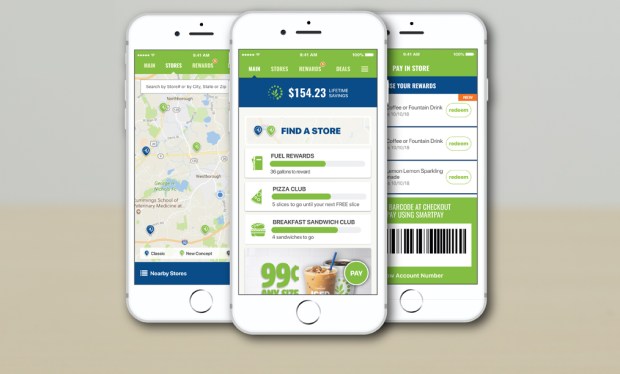Payment Apps Breathe New — Or Retro — Life Into Convenience Stores

Here are two ideas that appear contradictory, but are combining in a way that could significantly change convenience store commerce and payments:
First, those retail locations, once dismissively called “gas stations” — where hot dogs resided under heat lamps for days on end — are developing into places that resemble the warm, welcoming country stores of the olden days. Second, the speed and widening functionality of payment apps developed by those merchants are vital to that transition, no matter how retro is might seem upon first glance.
Charles Jarrett, vice president and CIO of Cumberland Farms (a convenience store chain with some 600 locations in eight states), recently discussed the future of that type of retail with Karen Webster, and gave an update on how the company’s redesigned SmartPay mobile app is helping lead that transformation for the regional chain.
Some context might be helpful.
Cumberland Farms started business in 1939 — milkmen still made deliveries back then, and lunch counters attracted hordes of workers every weekday — and is still trying to move past its image of “a kind of crunchy gas station store, where the coffee is burnt,” according to Jarrett, echoing sentiments expressed in focus groups.
Don’t Call Them Gas Stations
That might be a bit unfair, not only for Cumberland Farms, but for many similar stores across the United States. That’s because those locations — with labels that have changed from “gas station” to “convenience stores” over the past generation or two — have grown beyond the place a shopper visits for “a pack of cigarettes, a fountain drink and a candy bar,” Jarrett said.
Now, odds are reasonably high that the store where a person stops for gas, or a snack, will offer gourmet sandwiches, high-quality coffee, extremely edible pizza and high-priced artisanal water. Jarrett said, “It’s almost going back to the old country model, or a deli.”
And those improvements are attracting millennial and Generation X consumers. He said, “These kids don’t mind paying $4 for a bottle of water, even if it’s the last $4 they have.”
Such consumers are moving into their peak earning years, presenting a solid opportunity for chains like Cumberland Farms to capture their loyalty. The shift promises to bring about another label change, too.
“They are going to call us something different,” he said. “We are not going to be convenience stores anymore.”
Better Retail Via Digital
Of course, that appealing future is not guaranteed. Those reborn stores will likely have a hard time surviving without a smart focus on digital payments, and the transaction and loyalty services that come with that. Cumberland Farms offers an example of what that means and how that is playing out: The “completely redesigned” SmartPay Check-Link mobile app has achieved positive results since its launch early this year, according to Jarrett.
Once limited to gas purchases, the app now enables food rewards (buy 10 slices of pizza and then get one free, for instance), coffee benefits (a free cup of joe after pumping 50 gallons of gas), and fuel discounts (10 cents off a gallon). At the end of 2017, right before the debut of the redesign, the app had attracted 30 customer reviews and an overall rating of 2.5 stars, Jarrett told Webster. Now, there are about 3,300 reviews and a 5-star rating.
In addition, the retailer has experienced a “1,000 percent increase” in purchases of pizza slices through SmartPay since Jan. 1.
The Appeal Of A Holistic View
For Cumberland Farms, the redesigned ACH-anchored app collects instant, post-checkout customer feedback (via a sad or smiley face emoji), along with the data collection that could lead to the chain offering more food rewards, and even a preorder service that would enable customers to pick up their sandwiches and other items without waiting. The retailer is also testing mobile checkout for coffee, enabling customers to fill their cups, then pay via the app without the assistance of a human clerk.
“We are evolving it into a holistic app,” Jarrett said, adding that there is robust debate within the company about what other payment options to add to SmartPay.
One key for moving payments further into the digital realm, and making transactions more efficient, is keeping SmartPay “very clean.” That means, in part, avoiding the clutter that comes with the games and point systems that are on some competing apps, he said. Cumberland Farms has not shied away from game experiences — its treasure hunt offering awarded 1,000 coupons for free cookies in just a couple of days — but the chain wanted to avoid having its app users engage in competitions for points.
Not diluting the Cumberland Farms brand has kept the chain from embedding its app and functions into other platforms, such as in-car navigation aids or voice-activated devices, such as Alexa.
“They want to co-brand with you, embed our offer within their offer,” he told Webster. “That dilutes our message. We are striving to build a distinct brand.”
Besides, the cost of working with such partners — even a fraction of a cent per action — can quickly add up for a merchant with such a high scale of transactions, he said. Either one or both of those problems will have to be solved before Cumberland Farms starts integrating its app into such platforms.
The early gains made by the redesigned app give Cumberland Farms more fuel to modernize its operations and move closer to that model of a 21st-century digital, yet retro, store. The children might not slide pennies across the counter for hard candy after school anymore, but at least the pizza will be fresh.
Served, of course, with a side of $4 bottled water.
